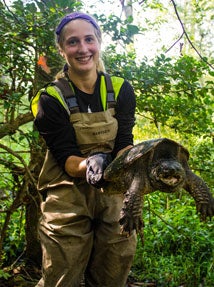 KINGSTON, R.I. – January 6, 2016 – University of Rhode Island student Elizabeth Shadle spent her childhood in Eagleville, Pa., catching frogs, turtles and whatever other wild creatures she could get her hands on. So it is no surprise that her senior research project involves amphibians and reptiles.
KINGSTON, R.I. – January 6, 2016 – University of Rhode Island student Elizabeth Shadle spent her childhood in Eagleville, Pa., catching frogs, turtles and whatever other wild creatures she could get her hands on. So it is no surprise that her senior research project involves amphibians and reptiles.
She recently completed a six-month project surveying Colonial National Historical Park in Virginia for amphibians and reptiles and studying their mortality on park roads. She trapped turtles in wetlands, hunted for snakes and salamanders under logs and rocks, biked park roads in search of roadkill, and used other strategies to locate as many species as she could find.
By the end of the summer, she and her co-researchers had found 52 species of reptiles and amphibians, including a venomous water moccasin and one of the largest salamanders in the country, the two-toed amphiuma, which can grow to nearly four feet in length.
“We found lots of exciting things, and I learned a great deal about how to conduct wildlife research,” said Shadle, an avid runner and president of the URI chapter of the Society of Wetland Scientists. “The biggest takeaway for me is that I really, really like amphibians and reptiles, and I want to work with them in the future.”
Using the data she collected in the park, Shadle conducted an analysis of the link between road mortality and habitat. She used Geographic Information Systems to plot the location of every turtle and frog killed on a park road and calculated the distance to the nearest wetland. Unsurprisingly, most of the aquatic species she found were closer to wetland habitats than to terrestrial habitats.
“It may sound obvious, but it’s important to collect the data. It means that proximity of wetlands is an important predictor of roadkill mortality for aquatic species,” Shadle said. “It has implications for species-specific wildlife management in the park.”
Shadle recommends that future studies take into account potential areas where drift fences could be installed along the roadway to direct the animals into culverts beneath the road and away from the road surface.
Her research was supported by the URI Coastal Fellows program, a unique initiative designed to involve undergraduate students in addressing current environmental problems. Now in its 20th year, it is based at URI’s College of the Environment and Life Sciences.
Students are paired with a mentor and research staff to help them gain skills relevant to their academic major and future occupations. Shadle’s research was part of a broader project on amphibians and reptiles in the park co-led by URI Research Associate Anne Devan-Song and Assistant Professor Nancy Karraker in the Department of Natural Resources Science.
Last month, Shadle exhibited her research results alongside those of 50 other URI Coastal Fellows, and her project was awarded first prize for its scientific merit and clarity.
During the winter break between semesters, Shadle is traveling to Panama for three weeks to work as an intern at a rehabilitation facility for howler monkeys. It’s a follow-up to a semester she spent in Costa Rica last year studying Spanish and environmental science. And when she returns for her final semester at URI, she will conduct independent research on lizard physiology and how lizards in urban environments are evolving.
She is also looking toward graduation in May and making plans for the future.
“I’m thinking about grad school, and I want to focus on wetlands conservation,” Shadle said. “But first I want to get an internship and spend a year or two getting some experience. I’m still undecided whether to go into academia, but I’m leaning toward working for a conservation organization or as a government biologist.”
The one thing she is sure of is that she wants a career studying amphibians and reptiles.
“They can really tell us a lot about the environment,” said Shadle. “And they’re a lot of fun because you can handle them pretty easily. I also really enjoy their wetland habitat, which is why I’m so focused on wetland conservation.”
Pictured above: URI student Elizabeth Shadle poses with a snapping turtle during research at Colonial National Historical Park in Virginia. (Photo courtesy of Elizabeth Shadle)

